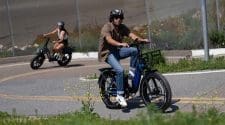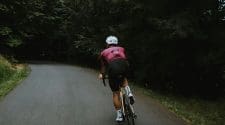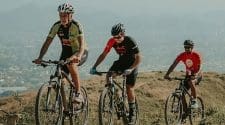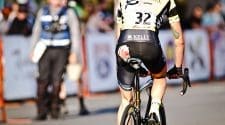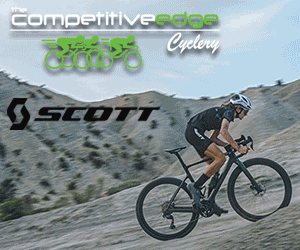The ride is done, legs are tired, and that post-ride satisfaction is settling in. But what comes next is just as important as the effort on the bike.
Most cyclists focus on pushing themselves during the ride, but proper recovery is the key to bouncing back faster, preventing injuries, and feeling stronger for the next one. Taking the right steps after cycling can make all the difference in how the body responds and performs.
That’s why we’ve rounded up seven simple tips to help your body recover properly so you can get back on the bike feeling refreshed and ready to go.
1. Prioritize Active Recovery
We all associate the word recovery with rest and lying down, not with any other work. What kind of recovery is it if I’m not in bed? Sounds strange, right? But, hey, active recovery is an incredibly important part of your post-ride routine .
Here, we are talking about low-intensity exercises that help your body recover while still keeping your muscles moving.
Everything is easy. A bit of light cycling, a short jog, or even a relaxed walk— that’s all it takes to get your blood flowing and help clear out the buildup in your muscles that can leave your legs feeling heavy.
We are not the only ones saying this; many professionals from various sports swear by it. It’s a go-to strategy for athletes who want to speed up recovery without losing momentum just enough to keep the legs moving and the blood flowing. It doesn’t have to be much, but that little bit of motion can make a big difference in how you feel the next day.
2. Stretch to Release Tightness
Cycling is a fantastic workout, but it’s also known for causing tightness in certain muscles, especially the hamstrings and quads. All that constant pedaling means your muscles are working in a shortened position, which, over time, can leave them feeling stiff and restricted. That’s where stretching comes in. It not only helps improve flexibility and release that tightness but also boosts blood flow to the muscles, helping your body recover faster and feel better for the next ride.
Here are a few key stretches to focus on post-ride:
Quads Stretch
Quad stretches, in addition to targeting the muscles at the front of the thigh, should also focus on the hip flexors, both of which work hard during every ride. The stretch is simple: stand on one leg, bend the other knee, and gently pull your foot toward your buttocks with your hand.
Hold each stretch for 15 to 30 seconds, and repeat two to four times per leg; that’s usually enough to feel the difference.
Hamstrings Stretch
Cyclists tend to have short hamstrings because the pedal stroke doesn’t fully extend them. To stretch your hamstrings, stand with your feet shoulder-width apart and keep your back straight. Slowly bend forward, reaching for the floor or your toes without rounding your back.
If reaching the floor is a challenge, no worries! You can place one foot up on a low stool or couch to help deepen the stretch.
Hold for about 20 to 30 seconds, then switch legs and repeat 2 to 3 times. Your hamstrings will thank you!
Hip Flexor Stretch
Long rides on the bike can leave your hip flexors feeling tight. To help stretch them out, start by getting into a lunge position. One foot should be forward, with the other leg extended behind you. As you stretch, make sure to push your hips forward; you’ll feel the stretch across the front of your hips.
Hold for 20 to 30 seconds, and repeat 2 to 3 times on each side. You’ll feel the tension melt away as your hips loosen up.
Glutes Stretch
Cycling really works your glutes, so giving them a good stretch afterward can make a big difference in your recovery. Start by lying on your back with your knees bent, then cross one ankle over the opposite knee. Gently pull the knee of your crossed leg toward your chest and hold for 20 to 30 seconds.
Switch sides and repeat. This stretch not only helps with your glutes but also loosens up your IT band, which can get tight from all that pedaling.
Repeat 2 to 3 times on each side, and trust me, your body will thank you later!
1. Hydrate Like a Pro
Water is life, but let’s be honest, so many of us forget about it during and after a ride. If that sounds like you, it’s time to change that habit! Hydration is key when it comes to recovery.
When you sweat, your body loses not only water but also important minerals. If you don’t replenish those, your body won’t bounce back as quickly as it should.
After your ride, make sure to drink water or something with electrolytes to help your muscles recover and prevent cramps. A good rule of thumb is to drink about 16–20 ounces of water for every pound you lose during your ride. Keep those fluids coming, and your body will thank you!
2. Don’t Skip Sleep
When we’re tired, our body naturally craves sleep. It’s no surprise—without enough rest, recovery takes longer, and you’ll feel even more exhausted on your next ride.
Aim for 7 to 9 hours of sleep each night, but after a tough ride, try to get closer to the higher end. Sleep is essential because it helps balance the hormones that support muscle recovery. So, getting that rest will have you waking up feeling strong, refreshed, and ready to hit the road again.
If falling asleep feels tough, consider a calming bedtime routine, whether it’s reading, stretching, or using relaxation techniques to unwind. A restful night’s sleep will leave you feeling recharged and ready to take on your next ride with fresh energy.
Sleep, recover, and get back at it!
Photo by LittPro Inc on Unsplash
3. Use a Foam Roller for Muscle Relief
A massage roller is a great tool made of foam or plastic, perfect for self-massage and stretching. It helps release muscle tension, improve circulation, and increase flexibility. The firm foam provides stability while still being soft enough for a comfortable massage.
It’s easy to carry, so you can use it at the gym, at home, outdoors, or even while traveling. Spend about 30 seconds to a minute on each muscle group, and you’ll feel the benefits.
Using a foam roller might feel a bit uncomfortable at first, especially in tight spots. But that’s actually a good thing because it means it’s doing its job. Stick with it, and you’ll soon feel more relaxed, less sore, and ready to get back on your bike.
4. Consider a Post-Ride Massage
Massage for recovery? Absolutely, yes! But what does it help with?
- Improves blood flow
- Eases tension in your muscles
- Release toxins
Choose the type of massage that works for you, whether it’s a classic massage or a massage gun. Both will certainly help with recovery.
However, if you’re feeling particularly stiff, it’s a good idea to leave it to the experts. Seeking out a specialist in sports recovery is a smart move. Considering wellness services, like a professional massage can be a great choice, as experts know exactly what to focus on and how to address your specific needs.
Seeking out a specialist in sports recovery can be a smart move. Professionals know exactly what to focus on and how to treat your muscles for the best results.
Photo by Rosa Rafael on Unsplash
7. Listen to Your Body
We’ve all been there, pushing ourselves past our limits. But here’s the thing: it’s always better to be safe than sorry. Listen to your body and give yourself the time you need to fully recover before jumping back into intense training. The last thing you want is to end up with an injury or burnout that sets you back.
Not feeling up to training today? Need another rest day to recharge? That’s completely fine. Take a moment to check in with your body and see how your muscles, joints, and energy levels feel. Adjust your training based on what your body needs. Recovery is just as important as the workout itself, and finding the right balance is key.
Recover Right, Ride Stronger
Riding your bike is about more than just feeling the wind on your face or using it as the perfect excuse to sneak in an extra slice of cake. Sure, those are great reasons to ride, but the real magic happens when you see all the benefits it brings to your body and mind
Don’t let the wind in your face or the excuse to eat an extra slice of cake be the only reason you ride your bike. While they’re fun motivators, the real benefits of cycling are something you can feel for yourself. It strengthens your body, clears your mind, and gives you a sense of accomplishment.
But here’s the catch—if you’re putting in the effort on your ride, it’s just as important to recover afterward. Recovery is every bit as important as the ride itself. It helps you come back stronger the next day, ready to take on even more.
So, recover well, ride strong, and enjoy every mile!
Top photo – Photo by Tuvalum on Unsplash
No products found.







